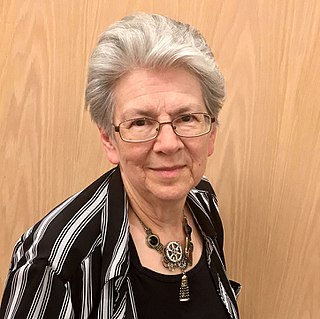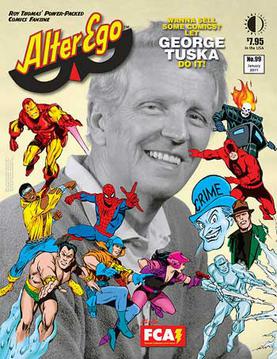Related Research Articles
A graphic novel is a long-form work of sequential art. The term graphic novel is often applied broadly, including fiction, non-fiction, and anthologized work, though this practice is highly contested by comics scholars and industry professionals. It is, at least in the United States, typically distinct from the term comic book, which is generally used for comics periodicals and trade paperbacks.

Comics Buyer's Guide, established in 1971, was the longest-running English-language periodical reporting on the American comic book industry. It awarded its annual Comics Buyer's Guide Fan Awards from 1983 to circa 2010. The publication ceased with the March 2013 issue. The magazine was headquartered in Iola, Wisconsin, after originally being published in the Quad Cities region.

witzend, published on an irregular schedule spanning decades, is an underground comic showcasing contributions by comic book professionals, leading illustrators and new artists. witzend was launched in 1966 by the writer-artist Wally Wood, who handed the reins to Bill Pearson from 1968 to 1985. The title was printed in lower-case.

Alfonso Williamson was an American cartoonist, comic book artist and illustrator specializing in adventure, Western, science fiction and fantasy.
TwoMorrows Publishing is a publisher of magazines about comic books, founded in 1994 by John and Pam Morrow out of their small advertising agency in Raleigh, North Carolina, United States. Its products also include books and DVDs.

Maggie Thompson, is an American longtime editor of the now-defunct comic book industry news magazine Comics Buyer's Guide, science fiction fan, and collector of comics.
The Alley Award was an American annual series of comic book fan awards, first presented in 1962 for comics published in 1961. Officially organized under the aegis of the Academy of Comic Book Arts and Sciences, the award shared close ties with the fanzine Alter Ego magazine. The Alley is the first known comic book fan award.
Jerry Gwin Bails was an American popular culturist. Known as the "Father of Comic Book Fandom," he was one of the first to approach the comic book field as a subject worthy of academic study, and was a primary force in establishing 1960s comics fandom.
Batmania is a term coined by Billy Joe (Biljo) White in the early 1960s and the title of his influential fanzine dedicated to the DC comic book character Batman. The name is "almost certainly" a nod to the then-prominent term "Beatlemania" used to describe the impact of the Beatles in popular culture. When White first published Batmania, interest in the Batman character was at a low point; however, due to changes credited largely to DC editor Julie Schwartz, comic sales improved and the character built a wave of popularity that led to the 1966 Batman television series. White and his fanzine were credited with helping to focus the energy of the dedicated fans during this time.

Alter Ego is an American magazine devoted to comic books and comic-book creators of the 1930s to late-1960s periods comprising what fans and historians call the Golden Age and Silver Age of Comic Books.

John Workman is an American editor, writer, artist, designer, colorist and letterer in the comic book industry. He is known for his frequent partnerships with writer/artist Walter Simonson and also for lettering the entire run of Grant Morrison/Rachel Pollack's Doom Patrol.
William Carl Schelly was an Eisner Award-winning author who chronicled the history of comic books and comic book fandom, and wrote biographies of comic book creators, including Otto Binder, L.B. Cole, Joe Kubert, Harvey Kurtzman, John Stanley, and James Warren as well as silent film comedian Harry Langdon.

Sheldon "Shel" Dorf was an American comic book enthusiast and the founder of San Diego Comic-Con International. Dorf was also a freelance artist and graphic designer, who lettered the Steve Canyon comic strip for the last 12 to 14 years of the strip's run.

Graphic Story Magazine was an American magazine edited and published by Bill Spicer in the late 1960s and early 1970s. Attempting to find a new direction for narrative art and a point of departure from commercial comic book stories, this journal of criticism and artwork evolved from Spicer's previous magazine, Fantasy Illustrated.

The Comic Reader (TCR) was a comics news-fanzine published from 1961 to 1984. Debuting in the pre-direct market era, TCR was the first regularly published comics industry news fanzine, and was able to secure many contacts from within the ranks of the larger publishers. As TCR increased in popularity and influence, it was able to attract professional artist to illustrate the covers. TCR also proved to be a launching pad for aspiring comic book creators, many of whom published work in the fanzine as amateurs. Contributors from the world of fandom included founding editor Jerry Bails, key editor Paul Levitz, Paul Kupperberg, Tony Isabella, Byron Preiss, Neal Pozner, Don Rosa, Carl Gafford, and Doug Hazlewood.

Rocket's Blast Comicollector (RBCC) was a comics advertising fanzine published from 1964 to 1983. The result of a merger with a similar publication, RBCC's purpose was to bring fans together for the purpose of adding to their comic book collections. It also proved to be a launching pad for aspiring comic book creators, many of whom corresponded and exchanged their work through RBCC, and published work in the fanzine as amateurs.
The Academy of Comic-Book Fans and Collectors (ACBFC) was the first official organization of comic book enthusiasts and historians. Active during the 1960s, the ACBFC was established by Jerry Bails, the "father of comics fandom". A vital player in the development of comics fandom, the ACBFC brought fans of the medium together, administered the first industry awards, and assisted in the establishment of the first comic book fan conventions.
Douglas Bruce Berry was an American comic book artist who is best known as the inker of several of Jack Kirby's comic book series in the 1970s.
Street Code is both the short, ten page autobiographical comic story and the 2009 mini-comic by American writer-artist Jack Kirby. Both Bill Sienkiewicz and Jeff Zapata consider it among Kirby's greatest works, and it supplanted all other works in the minds of Jack and wife Roz. Roz appreciated it so much she framed the two-page spread from the story and gave it pride of place on her wall. It was commissioned by Richard Kyle in 1983 but did not see print until 1990 in Argosy vol.3 #2, with lettering by Bill Spicer. The story was shot from Kirby's pencils. Kyle intended to print it with a colored tone behind it, which Kirby requested not be too colorful, but rather drab to suit the times. Kyle said
"I was troubled by the production errors in "Street Code", ... I should have served Jack better. But, although a hundred comic editors could have asked for this story at any time in Jack's career, they never did. "Street Code" lives because of Argosy, and will be remembered because of Jack Kirby - and because it says what the graphic story could have been and may still become."
David A. Kaler is an American writer. He was a primary force in establishing 1960s comic book fandom, particularly through the form of the comics convention. Later, he had a short-lived career as a comics writer for such publishers as Charlton Comics, DC Comics, and Warren Publishing.
References
- 1 2 3 Schelly, Bill. Founders of Comic Fandom, 2010.
- ↑ Grant, Steven. Comic book Resources, October 27, 1999.
- ↑ Morrow, John, ed. (February 19, 2004). Collected Jack Kirby Collector. TwoMorrows Publishing. p. 129. ISBN 1893905004.